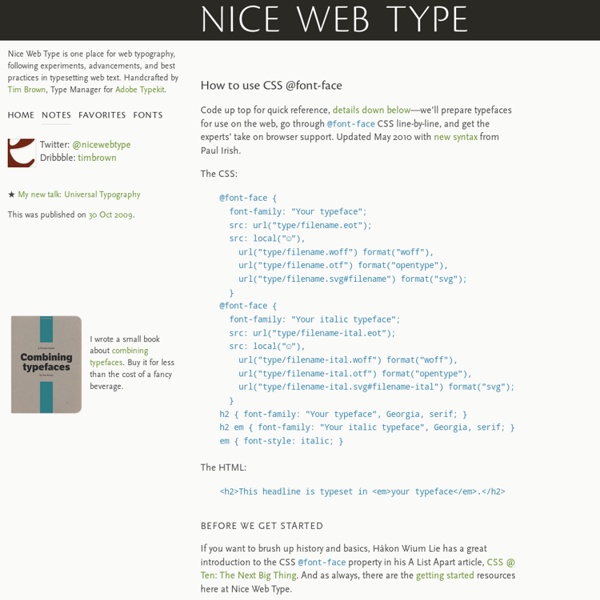Nice Web Type – How to use CSS @font-face

Becoming a Font Embedding Master
I've spent a couple days worth now trying to figure out the best and most complete approach to font embedding using @font-face. It really is a dark art that must be mastered. It is by no means a straightforward process. Font Formats Generally speaking, these days, a font on our system is going to be one of two formats: TrueType (with a .ttf file extension) or OpenType (with a .otf file extension). Licensing, and Browser Support Licensing Licensing is one of the biggest hurdles. Even many free fonts have limitations on how they can be used, often times requiring specific directions on linking back to the original source or only using them in non-commercial sites. These days, a number of resources are popping up—especially those dedicated to font embedding. Browser Support Which leads me into the other major issue, browser support. Okay, that's decent already but we can do better. If you have an OTF file, you'll need to convert it into a TTF file before you can convert it into an EOT.
New High-Quality Free Fonts
The Essential Guide to @font-face
Fonts on the Web The days of being limited to a handful of fonts on the web are very close to being a thing of the past. The problem is no longer a lack of viable solutions, but rather, an abundance of them. Technologies like Cufon, sIFR, FLIR and @font-face all represent different groups of developers placing bets on what they believe to be the future of web typography. There is, as of yet, no consensus in this ever-evolving game. Further, even the most popular browsers support each of these technologies in widely varying degrees. However, the @font-face CSS method is among the strongest, simplest and most flexible competitors in this game. This guide will teach you how to implement @font-face with cross-browser compatibility and will also look at a number of the supporting services that have arisen, making it even easier to use custom fonts in your web designs. Licensing and Free Fonts Font licensing presents one of the largest headaches and stumbling blocks to great typography on the web.
tinytype
Owner's Manual Perhaps a more accurate description would be an incompatibility table. This shows the state of default system fonts across the most popular platforms. I put this together as a way of finding alternatives to certain webfonts when page weight starts to get too heavy. Notes and Resources Android fonts from versions 1.6 and up except Roboto which exists on version 4.0/Ice Cream Sandwich and up (ht — Stu Robson).
한국워드프레스사용자모임 | 워드프레스를 사용하는 사람들의 커뮤니티 한국워드프레스사용자모임 | 워드프레스를 사용하는 사람들의 커뮤니티
CSS Fonts Module Level 3
Abstract This CSS3 module describes how font properties are specified and how font resources are loaded dynamically. The contents of this specification are a consolidation of content previously divided into CSS3 Fonts and CSS3 Web Fonts modules. The description of font load events was moved into the CSS3 Font Load Events module. Status of this document This is a public copy of the editors' draft. The (archived) public mailing list www-style@w3.org (see instructions) is preferred for discussion of this specification. This document was produced by the CSS Working Group (part of the Style Activity). This document was produced by a group operating under the 5 February 2004 W3C Patent Policy. See the section CR Exit Criteria for details on advancing this specification to W3C Recommendation. Features at risk The following features are at risk; if interoperable implementations are not found, they may be removed to advance the other features in this specification to Proposed Recommendation: weight
iWeb Widgets, Tutorials, Tips, and Tricks | Beyond iWeb
» CSS Trick: Turning a background image into a clickable link
One of the things I most often get asked by people trying to master HTML and CSS is “How do I make a background image clickable?” It’s easy to wrap a regular image tag in a link, but what if your design or situation required that you use a background image? It’s actually quite simple. Just follow these steps and I’ll show you how to make a clickable background image like this: Range Web Development Start with just a link exactly as you would make it for any other purpose, and make sure to give the link an id so that we can use that to apply our styles: That’s all the (X)HTML you’ll need to make your background image clickable. So, how can we make a background image a clickable link? At this point it should look something like this: Range Web Development Now all we need to do is hide the text. And the finished product looks like this: Range Web Development And there you have it – a quick CSS trick with clean markup that turns your background images into clickable links.
Related:
Related:



